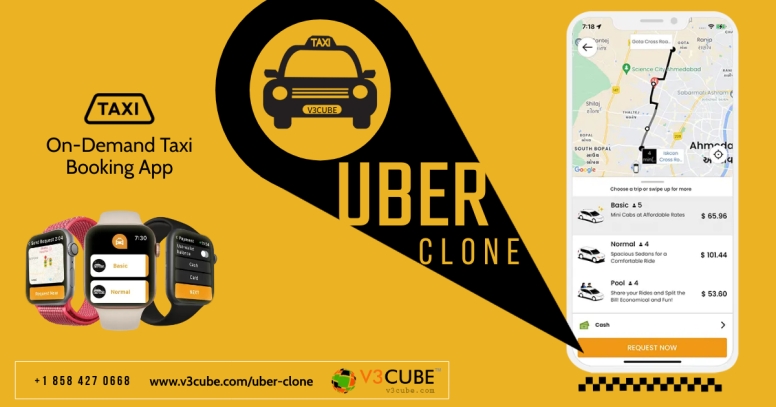Introduction
The on-demand transportation industry has witnessed a massive transformation in recent years, thanks to the advent of Uber and similar platforms. These platforms have revolutionized the way people travel by providing convenient, affordable, and efficient transportation services at their fingertips. If you’re intrigued by the success of Uber and want to establish your own on-demand transportation service, developing an Uber clone app can be a viable option. In this article, we will explore the process of creating your own on-demand transportation service with an Uber clone app, from understanding the concept to launching and marketing your service.
Understanding Uber Clone Apps
An Uber clone app is essentially a replica of the popular Uber platform, tailored to meet the specific needs of your transportation service. It incorporates the key features and functionalities of Uber, allowing users to book rides, track their drivers in real-time, and make cashless payments. Uber clone apps are designed to provide a seamless experience to both passengers and drivers, enabling you to establish a successful on-demand transportation business.
Key Features of an Uber Clone App
To ensure the smooth functioning of your on-demand transportation service, it is crucial to incorporate the following key features in your Uber clone app:
User registration and authentication: Users should be able to create accounts and log in securely to access the app’s features.
Ride booking and tracking: The app should allow users to easily book rides by specifying their pickup and drop-off locations. Real-time tracking of the assigned driver should also be included.
Driver management and allocation: A robust driver management system is essential to efficiently allocate drivers to ride requests, taking into account factors such as proximity, availability, and user preferences.
Payment integration: Seamless integration with popular payment gateways is necessary to facilitate cashless transactions and ensure a hassle-free payment experience for users.
Rating and review system: Implementing a rating and review system enables users to provide feedback on their ride experiences, ensuring transparency and accountability.
Developing Your Own Uber Clone App
Creating a successful Uber clone app involves several steps, including market research, technology selection, design, development, and integration. Here’s a breakdown of the key considerations in each phase:
Identifying the target market and competitors: Conduct thorough market research to understand the demand for on-demand transportation services in your target region. Analyze your competitors to identify their strengths and weaknesses.
Choosing the right technology stack: Selecting the appropriate technology stack is crucial for the smooth functioning of your app. Consider factors such as scalability, reliability, and ease of maintenance.
Designing the user interface and user experience: A user-friendly interface and seamless user experience are vital for the success of your app. Pay attention to intuitive navigation, clear visuals, and interactive elements.
Developing the core functionalities: Hire experienced developers to build the core functionalities of your Uber clone app, including user registration, ride booking, driver management, and payment integration.
Integrating third-party APIs and services: To enhance the functionality of your app, integrate third-party APIs for services like map navigation, SMS verification, and payment gateways.
Launching and Marketing Your On-Demand Transportation Service
Once your Uber clone app is developed, it’s time to launch and market your on-demand transportation service:
Preparing for the launch: Conduct thorough testing to ensure the app functions flawlessly. Create a marketing strategy, set pricing, and establish partnerships with local drivers and vehicle owners.
App store submission and approval process: Submit your app to relevant app stores and comply with their guidelines and regulations. Seek necessary approvals and certifications required for operating a transportation service.
Implementing effective marketing strategies: Utilize various marketing channels such as social media, online advertising, and partnerships with local businesses to promote your on-demand transportation service. Offer incentives and referral programs to attract new users and drivers.
Building partnerships with drivers and vehicles: Collaborate with local drivers and vehicle owners to expand your fleet and ensure a sufficient supply of drivers to meet the demand. Offer competitive incentives and driver support to attract and retain quality drivers.
Ensuring Success and Growth
To ensure the long-term success and growth of your on-demand transportation service, consider the following strategies:
Monitoring app performance and user feedback: Regularly monitor the app’s performance, including response time, stability, and user feedback. Address any issues promptly to provide a seamless user experience.
Iterating and improving the app based on user needs: Continuously gather user feedback and analyze data to identify areas for improvement. Regularly update and enhance your app’s features and functionalities to stay ahead of the competition.
Expanding to new markets and scaling the service: Once you establish a strong presence in your initial target market, consider expanding to new cities or regions. Adapt your service to cater to the specific needs and preferences of each market.
Incorporating new features and technologies: Stay up-to-date with the latest technological advancements in the transportation industry. Consider integrating features such as AI-powered route optimization, electric vehicle options, and multi-modal transportation to enhance the user experience.
Challenges and Considerations
While developing and operating an on-demand transportation service with an Uber clone app can be lucrative, it also comes with its own set of challenges and considerations:
Addressing legal and regulatory requirements: Ensure compliance with local laws and regulations pertaining to transportation services, licenses, insurance, and data privacy.
Ensuring passenger and driver safety: Implement robust safety measures such as driver background checks, vehicle inspections, and real-time monitoring to ensure the safety of both passengers and drivers.
Handling scalability and server capacity: Prepare your app and infrastructure for scalability to handle increased user demand. Invest in reliable servers and cloud services to ensure smooth operations even during peak times.
Dealing with competition and market dynamics: Stay informed about the competitive landscape and adapt your strategies accordingly. Offer unique features, competitive pricing, and exceptional customer service to differentiate your service from competitors.
Conclusion
Creating your own on-demand transportation service with an Uber clone app presents an exciting opportunity to enter the booming market of convenient and efficient transportation services. By understanding the concept of Uber clone apps, incorporating key features, and following a systematic development and marketing approach, you can establish a successful on-demand transportation service. However, it is essential to remain adaptable, prioritize user feedback, and stay updated with industry trends to ensure the long-term growth and sustainability of your business. Embrace the potential of an Uber clone app and embark on your journey to revolutionize the transportation industry.




